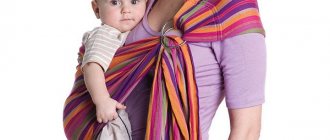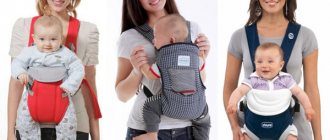Every woman has heard about women's compression stockings at least once in her life. While carrying a baby, knowledge about why to wear compression stockings for pregnant women becomes especially relevant.
So, pregnant women need maternity stockings or compression tights to avoid varicose veins. Because pregnant women are the second at risk after hereditary causes for the development of this disease. For a minute, varicose veins are diagnosed in almost 60% of the fair sex!
Why are pregnant women so at risk of developing these same varicose veins? There are several reasons:
- changes in hormonal levels. The level of the hormone prolactin increases, which “prepares” the female body for childbirth, relaxing the muscles and relieving spasms due to the inevitable growth of the uterus. The walls of blood vessels become less elastic;
- an increase in blood volume in the body of the expectant mother, as well as growth of the uterus and weight gain. All this contributes to additional pressure on the large veins that are located in the pelvic area. And compression of the veins, in turn, provokes difficulty in the outflow of blood from the lower extremities.
That is why women's compression stockings during pregnancy are very good for the prevention, as well as for the treatment of varicose veins in pregnant women. Stockings for pregnant women allow you to increase the speed of blood flow through the veins and minimize congestion.
But not all stockings are equally useful! Let's figure out how to choose women's compression stockings correctly and what to especially pay attention to.
How to choose women's compression stockings during pregnancy?
Women's compression stockings, like men's, can be of three types:
Hospital. Intended for hospital use only. For pregnant women: during and after childbirth. They are much easier to put on, unlike regular women's compression stockings, due to their elasticity. And, although hospital jersey can be worn for up to three days without taking it off, its service life is short. "Hospital" stockings are intended primarily for use in the "lying" position.
Medicinal. Prescribed to patients who have already detected varicose veins at different stages.
Preventive. Their purpose is to prevent varicose veins or its first signs, such as spider veins, swelling and heaviness in the lower extremities.
Types of women's compression garments for expectant mothers
In addition to the most popular maternity stockings, there are several other types of compression garments for women:
- Compression tights. During pregnancy, they will be indispensable specifically for those women who have dilated veins on the thighs or in the area of the external genitalia.
- Compression socks. Accordingly, they will be useful for those women whose areas of dilated veins are localized below the knee - mainly on the legs.
- Elastic compression bandages. This is the most rarely prescribed method for varicose veins in pregnant women. It is prescribed only for very severe dilation of the veins in a specific area of the legs.
When choosing women's compression stockings, it is necessary to take into account the immutable rule: the elastic band should be located at least five centimeters above the problem area.
A natural question arises: what is best for a woman during the period of bearing a child? Compression stockings or tights?
The fact is that tights for pregnant women in the abdominal area do not have any compression effect, so as not to harm the health of the baby and his mother. The product has an elastic spacer in this place for greater comfort.
Therefore, what to choose: women's stockings or tights is only a matter of personal preference!
And finally, about the most important thing.
Compression hosiery classes
A - class or preventive (10-15 mm Hg)
Wearing such jersey is recommended if the veins on the legs are not visible, but there are no more than two risk factors. For example such as:
- sedentary work or sedentary lifestyle;
— the woman uses oral contraceptives.
First class (23-32 mmHg) - light degree of compression
Intended for women with:
- hereditary factor in the formation of varicose veins;
- pregnancy;
- fatigue, heaviness in the legs, swelling in the evening;
- the appearance of a vascular “mesh” or “stars”, as well as dilated veins, the length of which is up to five centimeters;
- the presence of more than two risk factors for the development of leg disease.
Second class (18-21 mm Hg) - moderate degree of compression
Prescribed by a doctor if:
- there are pains, night cramps, circulatory disorders;
- the veins are dilated and their length is more than five centimeters;
- there are “nodes” - local areas of stagnation of blood in the veins.
In hospital settings, knitwear of the second compression class is also used.
Third class (34-46 mm Hg) - pronounced degree of compression
Prescribed STRICTLY by a doctor if:
- trophic ulcers;
- venous insufficiency.
Fourth class (from 49 mm Hg)
It is used very rarely for lymphatic edema and a long immobile lifestyle. For a woman - an expectant mother, this class of compression hosiery, otherwise called anti-embolic, is indicated only during childbirth to reduce the load on the blood vessels.
Medical compression stockings for women are marked exclusively in millimeters of mercury!
If a store or pharmacy has inexpensive women's stockings or tights on which it is written that they are Anti-varicose, 150 Denier, then you need to understand that these products have no medical value. And, unfortunately, there is no therapeutic effect here.
The numbers on the packaging, for example 18-21 mmHg, indicate how much pressure the stockings exert at the ankle level. In this place it is maximum, that is, 100%. The higher you go to the thigh, the less pressure the compression hosiery puts on the female body. So, in the hip area, it is already about 40%.
Compression stockings during childbirth
Compression underwear is a special medical underwear that puts pressure on the human body in order to prevent swelling and improve blood circulation in the veins. It is made from natural and synthetic fibers - cotton, nylon, elastodene. This type of underwear is thicker and stronger than conventional nylon products; it is used for medicinal and preventive purposes. Compression stockings and tights are designed in such a way that the pressure decreases from bottom to top, that is, blood moves more freely and more easily from the foot towards the heart.
Compression hosiery can be used for both therapeutic and preventive purposes.
During childbirth, the blood vessels of the female body experience severe overload. This tension is especially dangerous for the vessels of the legs, and blood clots can form in the deep veins of the lower extremities. The presence of such blood clots provokes the occurrence of thrombosis or thrombophlebitis, dangerous diseases with negative consequences, including death. Compression stockings are designed to reduce these risks:
- pressure equally distributed over the entire surface of the legs helps to establish uniform blood flow; constant pressure has a positive effect on the condition of blood vessels;
- pressure in the vessels increases, which reduces the chance of blood stagnation;
- Compression garments protect blood vessels from possible overloads during childbirth.
The appearance of spider veins on the legs is one of the symptoms of problems with veins and blood vessels
Instead of special stockings, elastic bandages are sometimes used to wrap the legs from the foot to the groin - they perform a similar role. An elastic bandage is cheaper than underwear, but during childbirth it can unravel; in addition, it is difficult to choose the right degree of pressure on the legs, so if there are indications, it is better to purchase stockings.
Even small fluctuations in pressure in the vessels can cause them to weaken and reveal spider veins on the legs, which not only does not look very beautiful, but also indicates the initial degree of varicose veins of the legs. To avoid this, you should not neglect your doctor’s recommendations if he advises you to use compression garments, and if he does not raise this topic, then ask yourself about measures to prevent problems with leg veins.
Video: why do you need stockings for childbirth?
Should everyone use them?
Many women are sure that compression garments during pregnancy and childbirth are only required for those expectant mothers who have already been diagnosed with vein problems. In fact, phlebologists—doctors who deal with venous pathologies—recommend using them, among other things, as prophylaxis to avoid varicose veins, thrombophlebitis, thrombosis and other vein pathologies. This is especially important if a pregnant woman experiences the following symptoms:
- spider veins or spider veins on the legs;
- swelling of the lower extremities;
- feeling tired or sore in the legs;
- cramps in the calf muscles;
- phlebeurysm;
- chronic venous insufficiency;
- thrombosis;
- venous eczema and/or dermatitis.
Is it possible to wear the same stockings that were worn during pregnancy?
Compression garments are divided into 4 classes depending on the pressure applied. A specialist should choose the right class of underwear for a pregnant woman, depending on the severity of her vein problems. If at the time of childbirth the condition of the woman’s vascular system allows her to use the same stockings that she wore during pregnancy, then it is entirely acceptable to wear them. But it is worth remembering that one of the main conditions for clothing used during childbirth is sterility, so stockings must be thoroughly washed before going to the maternity hospital.
You should wash compression hosiery carefully and carefully, using gentle washing powders and be sure to thoroughly rinse the laundry in clean water. It is not recommended to twist or wring out the laundry, as this can ruin the fine structure of the fibers; it is better to dry them flat on a horizontal surface.
Are stockings needed for a caesarean section?
If the need for stockings during natural childbirth is quite clear, then the question of the need for underwear during a cesarean section confuses many. The reason why compression stockings are also important for this method of delivery is that a cesarean section is an abdominal operation, and during it the blood vessels experience additional stress. When performing such an operation, the veins dilate, and the woman remains in a horizontal motionless state for a long time, which can provoke the onset of thromboembolism. In addition, the pregnant woman is given anesthesia, the components of which can negatively affect the entire cardiovascular system of her body.
Where to buy compression stockings for women?
It is quite possible to buy women's compression stockings in at least these three ways:
- At the pharmacy.
- A specialized store or orthopedic salon.
- In the online store.
When deciding where to buy women's compression stockings, it is advisable to take into account the fact that at least the first time you need to take the necessary measurements. Because accuracy in this case is crucial.
What measurements should you take before purchasing women's compression stockings for pregnant women?
If you are buying maternity stockings for the first time, it is better to find the nearest specialized store in your city. There, an experienced consultant will take the appropriate measurements:
- ankle circumference;
- shin at its widest part;
- popliteal region of the leg;
- hip and waist circumference (depending on whether you chose stockings or tights).
In addition to the exact size, a store consultant will be able to recommend stockings that a particular woman needs during pregnancy of a certain compression class and other properties. And next time, knowing in advance your sizes and the desired model, you can buy women’s stockings both in the pharmacy and in the online store.
Simply, if you make a mistake with the size of the stockings, you can end up with maternity stockings causing discomfort, or even not having the effect stated on the packaging at all.
Women's compression stockings will only have a medical effect if strict standards are met. In this case it is RAL-GZ-387 . This information must be indicated on the packaging of the laundry!
Further in the article, several well-established companies will be considered - manufacturers of women's compression stockings for pregnant women.
How to choose the right stocking size
To choose the right size correctly, you need to measure the following indicators with a regular measuring tape.
- Calf circumference: at the bottom (above the ankle), at the widest part, at the top (below the knee).
- Thigh circumference: 25–30 cm above the knee.
- Leg length: from the floor to the point where the hip circumference was measured
Important! It is recommended to take these measurements in the morning, as soon as you wake up, when your legs are not yet swollen.
The obtained measurements must be recorded and shown to a sales consultant at a pharmacy or specialty store. He will help you choose the right size compression stockings.
How long to wear compression stockings during pregnancy and how to put them on correctly
It is better to wear women's compression stockings during pregnancy for at least two hours, and ideally all day. It is better to put it on in the morning, without getting out of bed, on rested legs without swelling. But at night it is advisable to remove the therapeutic underwear and give your legs a rest!
And now, about some ways to help you put on compression garments during pregnancy without any problems:
- Regular women's compression stockings. How to wear:
- Open toe stockings. How to wear:
- Using a butler. This method is good for pregnant women in the last months of pregnancy or after a caesarean section when additional assistance is needed. For example, close people or special devices.
Butler is a special metal device consisting of a frame on which it is very convenient to stretch compression garments.
How to wear:
Additionally, to make the process easier, the following may be useful:
- Spray special for feet. You can use it to moisturize your skin before putting on compression garments.
- Latex gloves. They will increase adhesion to the material and prevent damage to the stockings.
Well, one last thing. Still, you need to read the instructions on the box before you start using women's compression stockings in order to avoid annoying mistakes and not spoil an expensive item.
How to choose compression garments?
Therapeutic knitwear for pregnant women should not be too tight or, on the contrary, dangle too freely. The degree of compression should be chosen only by a doctor - a phlebologist or surgeon. This is done taking into account the duration of pregnancy, as well as the presence or absence of contraindications.
Important! Before choosing underwear, it is also necessary to undergo a vein examination to identify possible pathologies.
So, which compression class to choose during pregnancy:
- First. Such stockings are worn to prevent varicose veins and thrombosis, and for complaints of heaviness in the legs.
- Second. Such underwear is recommended to be worn by pregnant women who already have varicose veins, nodes in the veins and obvious spider veins on the legs.
- Third. Prescribed for the most severe forms of varicose veins, as well as after surgery on the legs.
As for the material, it is best to choose products made from natural cotton. These stockings and tights do not have seams, and due to the special weaving of the thread, they will not put too much pressure on the legs and cause discomfort. It is also important that the fabric is breathable and your feet do not sweat.
Ideally, the product packaging should have a special RAL symbol, this means compliance with international quality standards.
The best brands at the moment are:
- Intex (Russia);
- ORTO (Italy);
- Venotex (USA);
- Copper (Germany);
- Tiana (Italy);
- Sigvaris (Switzerland).
Prices vary from 400 to 5000 rubles depending on the manufacturer. It is better to choose stockings in the price category from 1,500 rubles - too cheap products, although not inferior in compression quality, wear out too quickly.
If you need to wear not only stockings, but also tights, in addition to correctly selected sizes and materials, the product should have an elastic insert on the stomach.
The stockings themselves can be combined with maternity bands, which will help maintain the stomach in the correct position. This is a good prevention of hernia and back pain, since the bandage allows you to evenly distribute the load on the spine.
How not to make a mistake with sizes
When choosing compression stockings for pregnant women, not only the degree of compression and material are important, but also the size. You can take the necessary measurements at home. In order for compression garments to fit all parameters, you need to measure in centimeters:
- ankle circumference;
- circumference of the shin under the knee;
- hip circumference above the knee (at a height of about 25 cm for women of average height and 30 cm for tall women);
- leg length from the bottom point to the thigh circumference measurement line or to the groin, in case of choosing tights.
When buying tights, in addition to standard measurements, you need to take measurements from the waist and hips. The resulting dimensions will allow you to choose the underwear of the required size, but it is worth considering that different manufacturers have different sizing charts. It is best to entrust the selection of product size to a consultant in an orthopedic salon.
Stockings for childbirth
To avoid the development of thrombophlebitis and varicose veins in women in position during labor overload, gynecologists and obstetricians also recommend special women's compression stockings for childbirth. Compression stockings for women create the necessary pressure in the legs, evenly distributing blood throughout the vessels of the legs. Thereby preventing blood stagnation, therefore the risk of varicose veins is significantly reduced.
Women's stockings for childbirth are made from natural and synthetic hypoallergenic materials in white and cream colors with silicone elastic at the top of the thigh.
They can be either open-toed or with holes on the feet for better ventilation, moisture and air exchange.
A separate row includes women's compression stockings for childbirth, which are used for caesarean section . The use of anesthesia and a long stay in a horizontal position increase the risk of thromboembolism.
How compression stockings for women correctly
How to choose compression stockings for childbirth
A gynecologist and phlebologist will help you choose stockings for childbirth; when choosing the right compression garments and their class for a particular woman in labor, they will take into account several factors: the general well-being of the expectant mother; what diseases accompany pregnancy are there; How the pregnancy went in general and others.
For example, during natural childbirth and completely healthy veins, hospital compression stockings for women of the 1st class . If a caesarean section is planned or there are already leg diseases, then women's hospital stockings of the 2nd class .
In any case, the final verdict will be made by the doctor observing the woman during pregnancy.
When to wear women's stockings for childbirth
To wear women's compression stockings for childbirth:
- In natural childbirth: already at the first contractions. It is not forbidden to put it on earlier if there is uncertainty that it will be possible to do it during the break between contractions.
- For a planned caesarean section: right before surgery.
But again, all this if the doctor has not prescribed ANOTHER regimen for wearing women’s compression underwear.
When to take off stockings after childbirth
You can remove compression stockings after childbirth:
Natural birth and completely healthy veins: 5-7 days.
Caesarean section: no earlier than 2 weeks.
You can’t remove it on the first day because of the anesthesia in the blood, which dilates the blood vessels.
If there are already some problems with the veins, only a phlebologist can tell you the exact period of wearing compression garments for women.
How to choose the right one
Its functionality depends on how correctly the knitwear is selected. The main criterion is individual parameters. When purchasing compression hosiery, the volume of the ankle and mid-calf is taken into account. To make the choice easier, some manufacturers indicate additional information on the packaging - length from foot to knee and shoe size.
Compression garments are selected taking into account the following volumes:
- along the line under the buttocks;
- along the mid-thigh line;
- under the kneecap;
- along the mid-calf line;
- along the narrowest part of the lower leg.
Manufacturers use different size tables. This must be taken into account to avoid mistakes. The technique of wearing compression hosiery is no less important than the correct choice. The algorithm consists of the following stages:
- Roll the stockings into a tube so that the toe part becomes accessible for putting on (the roll is rolled from the top cut inside out);
- Put the stockings on your feet and straighten them along your legs;
- Secure it to your belt.
Stockings should only be worn on dry skin. It is better to do this immediately after waking up and taking a shower.
Knitwear used for preventive purposes is worn when moving, playing sports, and flying. You can wear it every day. Stockings must be removed at night. When prescribing compression garments, the doctor gives more specific instructions for its use.
Like any item of clothing, stockings need to be washed. This should only be done manually using mild detergents. Drying is carried out naturally. It is prohibited to hang knitwear on radiators and electric heating devices.
The period of wearing one pair of stockings is no more than 6 months. Medical knitwear from well-known brands has a shelf life of 10 months. After this, the material loses its compression properties, so it is periodically updated.
Type of compression stockings
Each woman can choose medical knitwear based on her own preferences. Lingerie is available in the form of stockings, tights, and golf.
A special feature of hosiery is its wide range of models. This makes it possible to choose the appropriate knitwear for certain parameters. The classic version has a length from heels to hips. This model is best used in cases of varicose veins spreading above the level of the knees.
Knee-length stockings are called knee-length stockings. This option is more suitable for those who have signs of impaired blood flow in the calves and ankles. They are also recommended for sports.
The range of medical knitwear includes stockings fitted under a belt. Some options are equipped with a fastener at the waist. This prevents the product from slipping or rolling while walking.
For a comfortable fit of stockings on the foot, models without heels and toes are available. This option can be used on one leg if signs of venous disease appear only on the left or right limb.
Hospital-type knitwear has the highest compression rate. Anti-embolic stockings are recommended for use during strip or local operations. They facilitate and speed up the recovery process after surgery.
Anti-embolic jersey is prescribed:
- intensive care patients;
- during operations to regulate blood circulation;
- during endoprosthetics and after it;
- rehabilitation;
- bedridden patients who remain immobile for a long time;
- for preventive purposes.
Hospital underwear is indicated for use by pregnant women:
- during childbirth;
- caesarean section;
- in the postpartum period.
Following your doctor's recommendations regarding wearing compression stockings reduces the risk of complications and congestion in the veins and blood vessels.
By class
There are three types of compression garments.
- Preventive – this includes class 1 models.
- Medical – 2nd and 3rd classes.
- Hospital antiembolic.
During pregnancy, the first two types of knitwear can be prescribed. Models for women in delicate situations have elastic inserts in the upper part. This ensures a tight fit to the abdomen without a compressive effect. Depending on the compression class, the compression force on the lower leg is adjusted.
Tips: how to choose compression stockings during pregnancy
It is better to buy women's compression underwear, taking into account some nuances of choice:
- Compression knitwear must be purchased of high quality and durable, which means it must comply with the RAL standard. And the corresponding note must be on the box with the product.
- There is another standard: Oko-Tex Standard 100, a note about which must be present on the packaging. Indicates the quality of the materials used in knitting.
- It makes sense to pay attention to this very knitting. The best choice would be seamless stockings.
- A warranty is required. It must be at least six months.
- During pregnancy, the best thing is to give preference to women's stockings with the highest content of natural threads and the lowest content of lycra.
- Of course, you should only purchase compression stockings for pregnant women in pharmacies and specialized stores.
- If a pregnant woman has no problems with veins, she can purchase A-class . But further, compression garments should be selected exclusively by a specialist!
Video: PREGNANCY | Are compression stockings really necessary for childbirth?
What are the risks for a pregnant woman?
- During delivery by cesarean section, the blood vessels experience greater stress. Blood clots may appear. If a pregnant woman already has a disease associated with blood vessels, then the movement of blood clots can cause blockage of the artery.
- During surgery, the veins are dilated, and in combination with the horizontal position of the body, the woman in labor may experience thromboembolism.
- Some components included in anesthesia have a negative effect on the circulatory system of a woman’s body.
- Sometimes pregnant women have their legs wrapped with elastic bandages before giving birth. If this procedure is carried out by an experienced person, then there should be no fear for the health of the woman in labor, but it is better to choose stockings.
During surgery, the veins are dilated, and in combination with the horizontal position of the body, the woman in labor may experience thromboembolism
- After the baby is born, doctors recommend that the young mother wear the compression accessory in which the woman gave birth for several days. This is explained by the presence of drugs included in the anesthesia and the continuation of their dilating effect on the blood vessels.
- Additional support for proper blood circulation in the legs of a woman in labor is provided by medical knitwear for 2-3 days after surgery. It is recommended to remove stockings only 3-5 days after cesarean section.
- It is better to buy medical underwear after a doctor’s prescription. But if the doctor does not talk about the need to purchase medical knitwear for childbirth, then a consultant from a specialized store will help you make the right choice. In a regular pharmacy there is not enough information about such a product.
When going shopping, you need to take measurements with a centimeter tape:
- ankles
- shins
- hips
By taking the necessary measurements, you can easily select the correct size of compression hosiery.
Contraindications to wearing women's compression stockings
A pregnant woman needs to be especially attentive to the needs of her body during this period. And, if the doctor has forbidden the wearing of women’s compression stockings for the following reasons, then you should listen to his recommendations so as not to aggravate the situation.
Here are a few problems that make wearing therapeutic underwear impossible:
- open wounds and pustules on the legs;
- atherosclerosis;
- cardiopulmonary failure, which gave complications in the form of impaired blood circulation;
- diabetes mellitus with complications in the lower extremities;
- acute thrombophlebitis;
- sepsis in the legs;
- any infections, dermatitis and inflammation;
- arterial insufficiency.
Causes and stages of varicose veins in pregnant women
Varicose veins occur due to stagnation of blood in the legs, when the vessels are too constricted and cannot provide normal blood flow. It is this blood that gradually begins to burst the veins from the inside.
According to the degree of manifestation, varicose veins can be divided into three stages:
- Stage 1 . During this period, no external symptoms are observed, since the deformation of the blood vessels in the legs is still too small. In the evening, a woman may feel tired in her legs or notice swelling, but by the next morning they have completely subsided.
- Stage 2. At this stage, the consequences of varicose veins are more noticeable; the pregnant woman experiences leg cramps. Most often this happens at night, and in addition to cramps, throbbing pain and sometimes itching may be felt.
- Stage 3. The last and most difficult stage, when the veins are so deformed that they are not only noticeable under the skin, but also noticeably protrude above it. In this case, the woman may not experience pain and may not even notice if the vessel bursts.
The main causes of varicose veins in pregnant women are:
- changes in hormonal levels (which in turn leads to thinning of the walls of blood vessels);
- increased volume of blood flow, creating additional stress on the veins;
- increase in weight and, accordingly, load on the legs.
The risk of varicose veins also depends on the individual characteristics of the woman, including genetic predisposition, as well as the general condition of the circulatory system.
Important! In pregnant women, varicose veins can appear not only in the legs; dilation of the veins in the area of the labia and anus is also possible. This requires urgent treatment, otherwise rupture of the vein will lead to very heavy bleeding.
How to care for compression stockings
Proper care will extend the life of your stockings and will delight you with their beautiful appearance.
- Women's compression stockings (tights, socks) are best washed by hand using baby gels or regular soap. If you still need to use a washing machine, you need to use a delicate wash cycle in warm water and turn off the spin cycle. Compression underwear cannot be washed together with other things!
- You should also not use conditioner, bleach, or wring out or iron medicinal knitwear.
- After washing, rinse carefully and do not twist. Women's compression stockings or tights should only be dried in a horizontal position! Otherwise, moisture will accumulate in the lower part of the stocking, which can contribute to their deformation.
- It is advisable to lubricate the silicone rubber on compression stockings for women after water procedures with a drop of alcohol using a cotton pad.
Popular companies producing women's compression garments for pregnant women
If there is a need to wear women's compression stockings during pregnancy, then it makes sense for the expectant mother to decide at the very beginning of her search on the material of the product, the manufacturer, the density and appearance of the compression stockings. It would be a good idea to listen to the recommendations of a doctor and an experienced consultant in an orthopedic salon.
The choice of stockings during pregnancy can also be influenced by:
- price and, accordingly, quality of the product;
- customer reviews;
- comfort and appearance.
Well, it is especially important that the product is certified, and the compression class is indicated (in mmHg). Without them, a purchase is a thoughtless waste of money.
SIGVARIS, Switzerland
Medi, Germany
VENOTEKS, Germany
ORTO, Spain
Relaxsan, Italy
INTEX, Russia
ERGOFORMA, Italy
Tonus Elast, Latvia
Bauerfeind, Germany
VARISAN, Italy
Popular brands producing compression stockings for pregnant women
The modern market offers many medicinal products. How not to get confused in such diversity? Pay attention to the manufacturers of compression stockings, whose products have shown good results during use during pregnancy, according to reviews. Among them:
- TONUS ELAST (Latvia). The brand is relatively inexpensive. The products are distinguished not only by their pleasant texture, but also by the fact that they fully perform the functions assigned to them - positive dynamics are noted from the first days of wearing. During use, the stockings do not stretch and retain their shape well.
- Medi (Germany). The cost of stockings starts from 1300 rubles and above. The manufacturer specializes in the production of anti-varicose products, so knitwear has excellent tactile and performance characteristics.
- Intex (Russia). The brand offers a wide range of anti-varicose medical products at an affordable price. Stockings not only have a good healing effect, but also have good workmanship.
- Relaxsan (Italy). Products from this manufacturer are inexpensive. And although the range of compression classes and design variations is quite wide, the stockings cannot boast of durability.
- Venoteks (USA). A popular brand due to its wide range of models and high-quality workmanship. The price range includes both budget models (1200 rubles) and expensive products (6000-7000 rubles).











